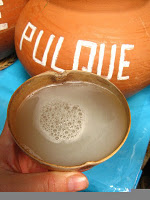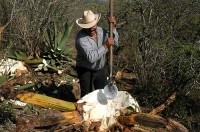This is part 3. To read part 2, Click Here.
 Pulque production is a long and delicate process. The maguey plant needs twelve years of maturation before the sap, or aguamiel, can be extracted, but a good plant can produce for up to one year. This aguamiel can be drunk straight, but it is alcoholic only after a fermentation process that can start in the plant itself. This liquid is collected twice a day from the plant yielding about five or six liters per day. Today, this liquid is collected with a steel scoop, but in the past an elongated gourd was used as a tube to suck the juice out. Between gatherings, the plants leaves are bent over the center where the juice collects to keep out bugs and dirt. This center is regularly scraped out to keep the plant’s production of sap active. Most maguey plants produce this aguamiel for about four to six months before they finally die.
Pulque production is a long and delicate process. The maguey plant needs twelve years of maturation before the sap, or aguamiel, can be extracted, but a good plant can produce for up to one year. This aguamiel can be drunk straight, but it is alcoholic only after a fermentation process that can start in the plant itself. This liquid is collected twice a day from the plant yielding about five or six liters per day. Today, this liquid is collected with a steel scoop, but in the past an elongated gourd was used as a tube to suck the juice out. Between gatherings, the plants leaves are bent over the center where the juice collects to keep out bugs and dirt. This center is regularly scraped out to keep the plant’s production of sap active. Most maguey plants produce this aguamiel for about four to six months before they finally die.
The collected juice is placed into fifty-liter barrels and carried from the field to the fermentation vats. These vats, called “tinas”, are located in a special building called a “tinacal”. This word derives from Nahuatl, “tina” and “calli” and means house of vats. When pulque haciendas reached their peak in the late 19th century, hacienda life revolved around these tinacals. It typically was a rectangular shed of stone with a wood roof. The upper parts of the walls opened for air circulation and the facades were sometimes decorated with indigenous designs or other images associated with the making of pulque. One popular motif was the discovery of pulque by Xochitl. Other popular elements were the image of the hacienda’s patron saint and the Virgin of Guadalupe. Inside were the vats, which were cowhide stretched over wooden frames lined up against the walls. In larger tinacals there were three or four rows of vats. Today, the tinas are made of oak, plastic or fiberglass and hold about 1,000 liters each.
 After placing the juice in the fermentation vats, mature seed pulque (semilla or Xanaxtli) is added to the naturally occurring yeast to “jump start” the process. Unlike beer, the fermenting agents present in the seed of pulque are bacteria of the species Zymomonas mobilis rather than yeast. Those in charge of the fermentation process guard their trade secrets, passing them on from father to son. Fermentation takes from seven to fourteen days, and the process seems to be more art than science. A number of factors can affect fermenting pulque such as temperature, humidity and the quality of the aguamiel.
After placing the juice in the fermentation vats, mature seed pulque (semilla or Xanaxtli) is added to the naturally occurring yeast to “jump start” the process. Unlike beer, the fermenting agents present in the seed of pulque are bacteria of the species Zymomonas mobilis rather than yeast. Those in charge of the fermentation process guard their trade secrets, passing them on from father to son. Fermentation takes from seven to fourteen days, and the process seems to be more art than science. A number of factors can affect fermenting pulque such as temperature, humidity and the quality of the aguamiel.
The process is complex, and can go sour at any point. For this reason, and perhaps due to its ancient “sacred” character, there are rituals and prohibitions. Religious songs and prayers may be offered, and women, children and strangers are not allowed inside the tinacal. Other superstitions include those against eating canned fish and wearing a hat inside the tinacal. The first is claimed to cause a bad taste in the pulque and the second is considered bad luck. To cleanse the bad luck, the offender must fill the hat with pulque and drink it down.
Just before the peak of fermentation, the pulque is quickly shipped to market in barrels. The fermentation process is continuous, so the pulque must be consumed within a certain time frame before it spoils, a factor that may have led to the slow spread of pulque consumption in the 19th and 20th centuries.
Where is pulque today? Is this a forgotten ancient drink from a time past? A historical footnote in tequila’s past, or is pulque rising again? To find out, Click Here.



